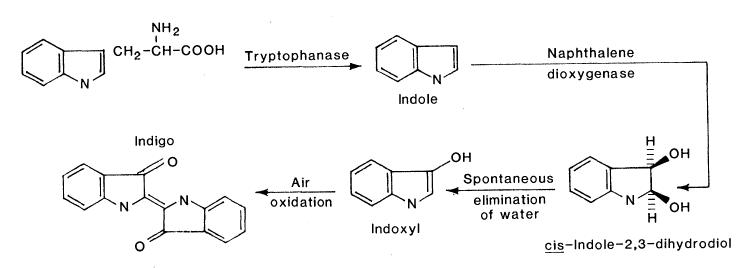Team:Cornell/project/wetlab/results/nah operon
From 2012.igem.org
(Difference between revisions)
| Line 74: | Line 74: | ||
<h3>Biosynthesis of Indigo</h3> | <h3>Biosynthesis of Indigo</h3> | ||
When the <i>nah</i> operon from the <i>nah7</i> plasmid is transformed into <i>E. coli</i> and expressed, the cells have the ability to produce indigo from tryptophan. Therefore, as an indirect proof of the <i>nah</i> operon's function, several cultures were set up to determine if indigo was present when supplemented tryptophan. <br><br><i>E. coli</i> contains the enzyme tryptophanase, which splits the indole group from the peptide backbone. Naphthalene dioxygenase, from the <i>nah</i> operon, then creates a compound which will spontaneously eliminate water and be air oxidized into indigo as the final product. | When the <i>nah</i> operon from the <i>nah7</i> plasmid is transformed into <i>E. coli</i> and expressed, the cells have the ability to produce indigo from tryptophan. Therefore, as an indirect proof of the <i>nah</i> operon's function, several cultures were set up to determine if indigo was present when supplemented tryptophan. <br><br><i>E. coli</i> contains the enzyme tryptophanase, which splits the indole group from the peptide backbone. Naphthalene dioxygenase, from the <i>nah</i> operon, then creates a compound which will spontaneously eliminate water and be air oxidized into indigo as the final product. | ||
| - | <br><br>The naphthalene dioxygenase gene will be isolated from the operon and created into a biobrick for future use of the enzyme in the synthesis of indigo from tryptophan or indole. | + | <br><br>The naphthalene dioxygenase gene will be isolated from the operon and created into a <a> href="https://2012.igem.org/Team:Cornell/project/wetlab/results/biobricks">biobrick</a> for future use of the enzyme in the synthesis of indigo from tryptophan or indole. |
</div> | </div> | ||
<div class="three columns"> | <div class="three columns"> | ||
Revision as of 21:59, 26 October 2012
nah Operon Expression
Biosynthesis of Indigo
When the nah operon from the nah7 plasmid is transformed into E. coli and expressed, the cells have the ability to produce indigo from tryptophan. Therefore, as an indirect proof of the nah operon's function, several cultures were set up to determine if indigo was present when supplemented tryptophan.E. coli contains the enzyme tryptophanase, which splits the indole group from the peptide backbone. Naphthalene dioxygenase, from the nah operon, then creates a compound which will spontaneously eliminate water and be air oxidized into indigo as the final product.
The naphthalene dioxygenase gene will be isolated from the operon and created into a href="https://2012.igem.org/Team:Cornell/project/wetlab/results/biobricks">biobrick for future use of the enzyme in the synthesis of indigo from tryptophan or indole.


Testing and Results
Cultures of DH5α containing the nah operon were started in LB broth with 200 μM tryptophan and 1x ampicillin. Six days after the initial cultures were started, the liquid culture appeared purple. After extracting with chloroform, the organic phase was a light purple color. Testing is being done to determine if this purple compound is indigo. Fig. 1. Pathway by which E. coli can produce indigo from tryptophan when expressing genes of the Nah7 operon. (Ensley et al., 1983)
Fig. 1. Pathway by which E. coli can produce indigo from tryptophan when expressing genes of the Nah7 operon. (Ensley et al., 1983)
 "
"







